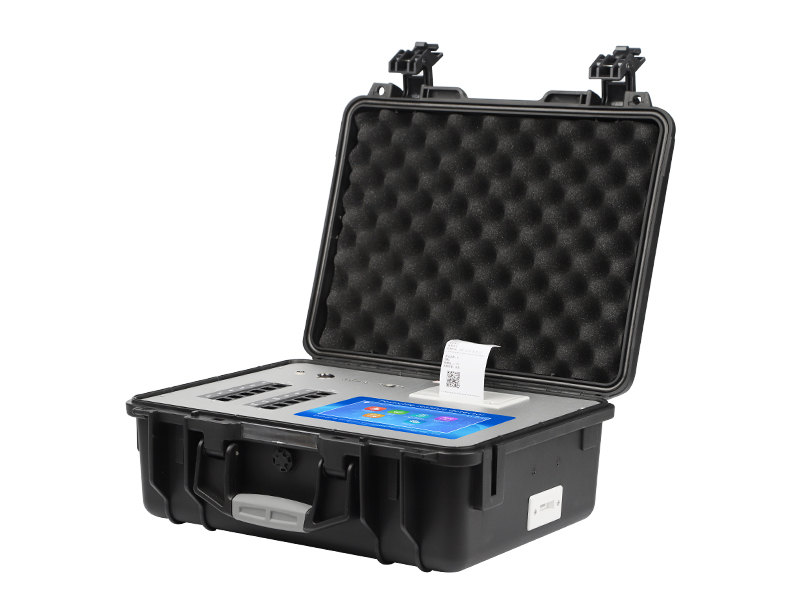In today's world, where food safety issues are increasingly emphasized, pesticide residue testing has become a vital component of agricultural product quality supervision. As an efficient and accurate detection tool, comprehensive pesticide residue detectors are playing an indispensable role in agricultural production, food processing, market regulation, and beyond.

I. Importance and Challenges of Pesticide Residue Detection
The widespread use of pesticides in agricultural production ensures crop yields but also brings significant residue risks. Long-term consumption of agricultural products with excessive pesticide residues may harm the human nervous and endocrine systems.
Traditional pesticide residue detection methods often require complex sample pre-treatment and specialized laboratory environments, taking several days from sampling to obtaining results. This delay cannot meet the demand for rapid screening in modern agricultural product circulation. The emergence of comprehensive pesticide residue detectors has successfully addressed this industry challenge, reducing detection time to within 30 minutes and greatly improving regulatory efficiency and market access speed.
II. Technical Principles and Core Functions
1. Detection Principles
Comprehensive pesticide residue detectors primarily employ two core technologies:
(1) Enzyme Inhibition Colorimetry
Based on the specific inhibition of cholinesterase activity by organophosphorus and carbamate pesticides. When such pesticides are present in a sample, enzyme activity is suppressed, leading to reduced color development. The inhibition rate is calculated by measuring absorbance changes to determine whether pesticide levels exceed standards. This method complies with the Chinese National Standard GB/T 5009.199-2003, with a detection limit of 0.1–5 mg/kg.
(2) Colloidal Gold Immunochromatography
Utilizes the specific antigen-antibody reaction to accurately detect targeted pesticides such as imidacloprid and carbofuran. This method features simple pre-treatment and a detection time of only 10–15 minutes, with sensitivity typically 1–2 orders of magnitude higher than the enzyme inhibition method.
2. Hardware Configuration
Modern comprehensive pesticide residue detectors adopt high-performance hardware architectures:
Main Control Chip: ARM Cortex-A7 quad-core processor, 1.88 GHz
Optical System: High-precision four-wavelength cold light source (410 nm as the primary detection wavelength)
Display System: 7-inch LCD touch screen with a Chinese operating interface
Power System: Dual AC/DC power supply with a built-in 6 Ah large-capacity lithium battery
3. Intelligent Functions
12-channel batch detection, processing 48–72 samples per hour
Wireless data transmission (WiFi/4G/GPRS), supporting cloud-based regulatory platforms
Rail-type automatic transmission scanning with automatic test card ejection
Built-in camera for automatic analysis of colloidal gold test card images
200,000 data storage capacity, supporting USB export and thermal printing
III. Technical Advantages
(1) Efficiency and Convenience
Compared to traditional laboratory testing, comprehensive pesticide residue detectors are user-friendly and can be operated by non-specialists after training, reducing the detection process time by over 80%.
(2) Multi-Residue Detection
A single device can cover organophosphorus, carbamate, and various specific pesticides, eliminating the need for multiple detection devices.
(3) Smart Connectivity
Real-time data upload to regulatory platforms enables big data analysis and risk early warning for food safety.
(4) Cost-Effectiveness
The cost per test ranges from a few yuan to tens of yuan, far lower than laboratory testing expenses, making it suitable for large-scale screening.
As a critical technical tool in the food safety defense line, comprehensive pesticide residue detectors are driving the transition of pesticide residue testing from the laboratory to the field, and from specialized to widespread use. With continuous technological advancements and expanding application scenarios, these instruments will play an increasingly important role in ensuring agricultural product quality safety and promoting sustainable agricultural development.
Address of this article:http://www.hmfoodtesting.com/article/155.html


 Current
location:
Current
location:





